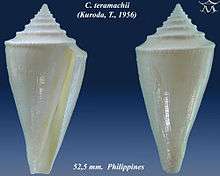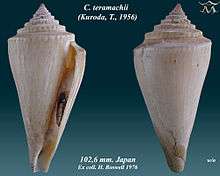Profundiconus teramachii
Profundiconus teramachii, common name Teramachi's cone, is a species of sea snail, a marine gastropod mollusk in the family Conidae, the cone snails and their allies.[1][2]
| Profundiconus teramachii | |
|---|---|
 | |
| Apertural and abapertural views of shell of Profundiconus teramachii (Kuroda, T., 1956) | |
 | |
| Scientific classification | |
| Kingdom: | Animalia |
| Phylum: | Mollusca |
| Class: | Gastropoda |
| Clade: | Caenogastropoda |
| Clade: | Hypsogastropoda |
| Clade: | Neogastropoda |
| Superfamily: | Conoidea |
| Family: | Conidae |
| Genus: | Profundiconus |
| Species: | P. teramachii |
| Binomial name | |
| Profundiconus teramachii (Kuroda, 1956) | |
| Synonyms[1] | |
| |
Like all species within the genus Profundiconus, these cone snails are predatory and venomous. They are capable of "stinging" humans, therefore live ones should be handled carefully or not at all.
Description
The size of the shell varies between 50 mm and 115 mm.
Distribution
This marine species occurs from Southeast Africa and the Philippines to Southern Japan, and off Queensland, Australia.
gollark: Yes, lots of people don't care.
gollark: Personally, I *don't*, it's very uncustomizable.
gollark: Well, lucky, I guess, except it's an iPhone so I don't really like it, but it has... good specs and such.
gollark: Unrelatedly, choosing a decent phone these days is hard.
gollark: Continuing on from what I said, though: I've also heard it said that house prices are high because you can borrow lots of money cheaply now because of low interest rates, and because houses are a long-term-ownership thing their demand is more affected by how much you can *borrow* more than how much you *have now*. I have no idea which of these, if any, is accurate.
References
- Bouchet, P. (2015). Profundiconus teramachii (Kuroda, 1956). Accessed through: World Register of Marine Species at http://www.marinespecies.org/aphia.php?p=taxdetails&id=581028 on 2015-03-29
- Puillandre N., Duda T.F., Meyer C., Olivera B.M. & Bouchet P. (2015). One, four or 100 genera? A new classification of the cone snails. Journal of Molluscan Studies. 81: 1–23
- Martens, E. von 1901. Einige neue Arten von Meer-Conchylien aus den Sammlugen der deutschen Tiefsee-Expedition. Sitzungsberichte der Gesellschaft Naturforschender Freunde zu Berlin 9: 14–26
- Motta, A.J. da 1985. Two new Conus species. La Conchiglia 17(190–191): 26–28 [27] [replacement name for Conus torquatus von Martens, 1901].
- Wilson, B. 1994. Australian Marine Shells. Prosobranch Gastropods. Kallaroo, WA : Odyssey Publishing Vol. 2 370 pp.
- Röckel, D., Korn, W. & Kohn, A.J. 1995. Manual of the Living Conidae. Volume 1: Indo-Pacific Region. Wiesbaden : Hemmen 517 pp.
- Filmer R.M. (2001). A Catalogue of Nomenclature and Taxonomy in the Living Conidae 1758 - 1998. Backhuys Publishers, Leiden. 388pp
- Tucker J.K. (2009). Recent cone species database. September 4, 2009 Edition.
- Tucker J.K. & Tenorio M.J. (2009) Systematic classification of Recent and fossil conoidean gastropods. Hackenheim: Conchbooks. 296 pp.
External links
- Kuroda, T. 1956. New species of Conidae (Gastropoda) from Japan. Venus 19(1): 1–16
- The Conus Biodiversity website
- Cone Shells – Knights of the Sea
- Puillandre N., Duda T.F., Meyer C., Olivera B.M. & Bouchet P. (2015). One, four or 100 genera? A new classification of the cone snails. Journal of Molluscan Studies. 81: 1–23
- "Profundiconus teramachii". Gastropods.com. Retrieved 16 January 2019.
| Wikimedia Commons has media related to Profundiconus teramachii. |
This article is issued from Wikipedia. The text is licensed under Creative Commons - Attribution - Sharealike. Additional terms may apply for the media files.